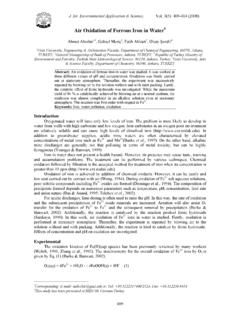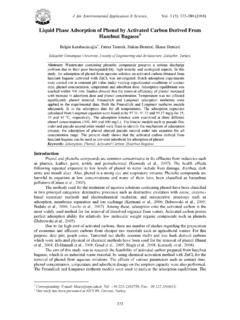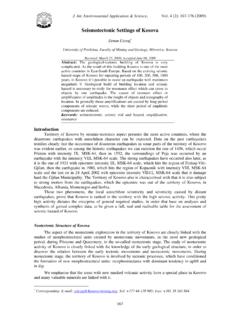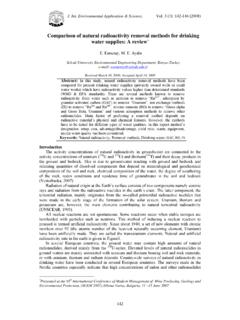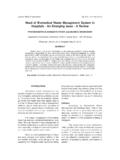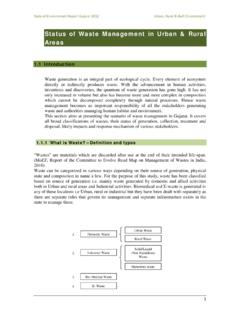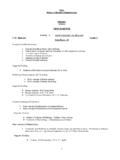Transcription of Management of Biomedical Waste in India and …
1 J. Int. Environmental Application & Science, Vol. 4 (1): 65-78 (2009). Management of Biomedical Waste in India and Other Countries: A Review B. Ramesh Babu*, Parande, R. Rajalakshmi, P. Suriyakala, M. Volga Central Electrochemical Research Institute, Karaikudi 630006, Tamilnadu, India Received July 29, 2008; Accepted March 16, 2009. Abstract: The objective of this study is (i) to summarize the rules for Management and handling of Biomedical wastes, (ii) to give the definition, categories of Biomedical wastes, suggested storage containers including colour-coding and treatment options, (iii) mainly to highlight the effects of Biomedical Waste in the environment such as air, land, radioactive pollution and (iv) disposal of wastes, regulation and recommendations. Health-care Waste Management in several countries including India is receiving greater attention due to stringent regulations.
2 The Waste generation rate ranges between and kg bed-1day-1. The solid Waste from the hospitals consists of bandages, linen and other infectious Waste (30-35%), plastics (7- 10%), disposable syringes ( ), glass (3-5%) and other general wastes including food (40-45%). Several survey works carried out by various research organizations by (Government and Non government and private sectors) have been discussed and reviewed in this paper. Keywords: Data Management , emissions, Biomedical wastes, hazardous Waste , health-care establishment, regulations, Waste - Management plan, Waste disposal. Introduction Bio- medical Waste ' means any Waste generated during diagnosis, treatment or immunization of human beings or animals. Management of healthcare Waste is an integral part of infection control and hygiene programs in healthcare settings.
3 These settings are a major contributor to community-acquired infection, as they produce large amounts of Biomedical Waste . Biomedical Waste can be categorized based on the risk of causing injury and/or infection during handling and disposal. Wastes targeted for precautions during handling and disposal include sharps (needles or scalpel blades), pathological wastes (anatomical body parts, microbiology cultures and blood samples) and infectious wastes (items contaminated with body fluids and discharges such as dressing, catheters and lines). Other wastes generated in healthcare settings include radioactive wastes, mercury containing instruments and polyvinyl chloride (PVC) plastics. These are among the most environmentally sensitive by-products of healthcare (Askarain et al., 2004; Remy, 2001). WHO stated that 85% of hospital wastes are actually non-hazardous, around 10% are infectious and around 5% are non-infectious but hazardous wastes.
4 In the USA, about 15% of hospital Waste is regulated as infectious Waste . In India this could range from 15% to 35% depending on the total amount of Waste generated (Glenn & Garwal, 1999; Anonymous, 1998; Chitnis et al., 2005). The Management of bio- medical Waste is still in its infancy all over the world. There is a lot of confusion with the problems among the generators, operators, decision-makers and the general community about the safe Management of bio- medical Waste . The reason may be a lack of awareness. Hence resource material on the environment for hospital administrators, surgeons, doctors, nurses, paramedical staff and Waste retrievers, is the need of the hour (Almuneef & Memish, 2003; Acharya &. Meeta, 2000). Sources of Bio- medical Waste While urban solid Waste has attracted the attention of town planners, environmental activists and civic administrators, there is yet lack of concern for some special sources of Waste and its Management .
5 One such Waste is bio- medical Waste generated primarily from health care establishments, including hospitals, nursing homes, veterinary hospitals, clinics and general * Corresponding: E-mail: Tel:+91-4565-227555, Fax:+91-4565-227779. 65. J. Int. Environmental Application & Science, Vol. 4 (1): 65-78 (2009). practitioners, dispensaries, blood banks, animal houses and research institutes. The other sources of Biomedical Waste are the following: Households, Industries, education institutes and research centres, Blood banks and clinical laboratories, Health care establishments (for humans and animals): (Anonymous, 2000; Chitnis et al., 2000). The sector generates all the types of Waste listed under the bio- medical Waste are shown in Figure 1. Primary source Other sources Hospitals, nursing Households, homes, veterinary Industries, education hospitals, clinics, institutes and research dispensaries, blood centers Figure 1.
6 Source of Biomedical wastes (The Gazette of India , 1998). Categories of Biomedical wastes Categories of Biomedical wastes are given in Table 1. Table 1. Categories of Biomedical wastes Category Source of Waste Treatment and Disposal 1 Human Anatomical Waste (human tissues, organs, body parts) Incineration /deep burial 2 Animal Waste (animal tissues, organs, body parts, carcasses, bleeding parts, fluid, blood and experimental animals used in research, Waste generated by Incineration /deep burial veterinary hospitals, colleges, discharge from hospitals, animal houses). 3 Microbiology & Biotechnology Waste (wastes from laboratory cultures, stocks or specimens of micro-organisms live or attenuated vaccines, human and animal Local autoclaving /. cell culture used in research and industrial laboratories, wastes from production microwaving incineration of biological, toxins, dishes and devices used for transfer of cultures).
7 4 Disinfection (chemical Waste Sharps(needles, syringes, scalpels, blades, glass, etc. that may cause treatment /autoclaving/. puncture and unused sharps) microwaving and mutilation/. shredding . 5 Incineration /destruction and Discarded Medicines & Cytotoxic drugs (wastes comprising of outdated, drugs disposal in secured contaminated and discarded medicines). landfills 6 Soiled Waste (items contaminated with blood and body fluids including cotton, Incineration autoclaving/. dressings, soiled plaster casts, lines, beddings, other material contaminated with microwaving blood. 7 Disinfection by chemical Solid Waste (wastes generated from disposable items other than Waste sharps treatment autoclaving/. such as tabbing, catheters, intravenous sets etc.) microwaving and mutilation/. shredding . 8 Disinfection by chemical Liquid Waste ( Waste generated from laboratory and washing, cleaning, house- treatment and discharge into keeping and disinfecting activities).))
8 Drains 9 Incineration Ash (ash from incineration of any bio- medical Waste ) Disposal in municipal landfill 10 Chemical treatment and Chemical Waste (chemicals used in production of biological, chemicals used in discharge into drains for disinfection, as insecticides, etc.) liquids and secured landfill for solids. Source: Biomedical wastes ( Management and Handling Rules, 1998). 66. J. Int. Environmental Application & Science, Vol. 4 (1): 65-78 (2009). Effects of Biomedical Waste The improper Management in bio- medical Waste causes stern environmental problems that causes to air, water and land pollution. The pollutants that cause damage can be classified into biological, chemical and radioactive. There are several legislations and guidelines in India concerning environmental problems, which can be addressed. The classification of radioactive Waste generated as part of bio- medical Waste is covered.
9 Some of the effects of pollution on air, radio activities, land, health and hazards are discussed (Sadhu and Singh 2003; ). Air Pollution Air pollution can be caused in both indoors and outdoors atmosphere. Biomedical Waste that generated by air pollution are been classified in three types namely-Biological, Chemical and radioactive (http://kspcb. ). In-door air pollution Pathogens present in the Waste can enter and remain in the air for a long period in the form of spores or as pathogens Segregation of Waste , pre-treatment at source etc., can also reduce this problem to a great extent. Sterilizing the rooms will also help in checking the indoor air pollution due to biological (Askarian et al 2004b; Baveja et al 2000). The indoor air pollution caused due to the above chemicals from poor ventilation can cause diseases like Sick Building Syndrome (SBS).
10 Proper building design and well-maintained air conditioners can reduce the SBS. Chemicals should be utilized as per prescribed norms. Over use of chemicals should be avoided (Bdour 2004, Saurabh &. Ram 2006). Out-door air pollution Outdoor air pollution can be caused by pathogens. The Biomedical Waste without pre-treatment if transported outside the institution, or if it is dumped in open areas, pathogens can enter into the atmosphere. Chemical pollutants that cause outdoor air pollution have two major sources-open burning and incinerators. Open burning of bio- medical Waste is the most harmful practice. When inhaled can cause respiratory diseases. Certain organic gases such as dioxins and furans are carcinogenic (Burd 2005). The design parameters and maintenance of such treatment and disposal technology should be as per the prescribed standards (Bdour 2004).

